Management Accounting Report: Techniques and Analysis
VerifiedAdded on 2020/12/29
|18
|5909
|166
Report
AI Summary
This report provides a comprehensive overview of management accounting, focusing on its role in financial decision-making within a business context. It begins by defining management accounting and differentiating it from financial accounting, highlighting its importance for internal analysis and strategic planning. The report then delves into various management accounting systems such as inventory management, cost accounting, and price optimization, explaining their functions and benefits. It also explores different management accounting reports, including budget reports, performance reports, and cost management reports, detailing their significance in evaluating performance and guiding business strategies. Furthermore, the report examines costing techniques, such as marginal costing and absorption costing, used to prepare income statements, and discusses various planning tools along with their advantages and disadvantages. Finally, the report analyzes how management accounting systems adapt to respond to financial problems, using examples like TESCO and LOREAL to illustrate its practical applications, ultimately emphasizing its role in achieving sustainable success. The report is structured to provide insights into the practical application of management accounting principles and techniques.
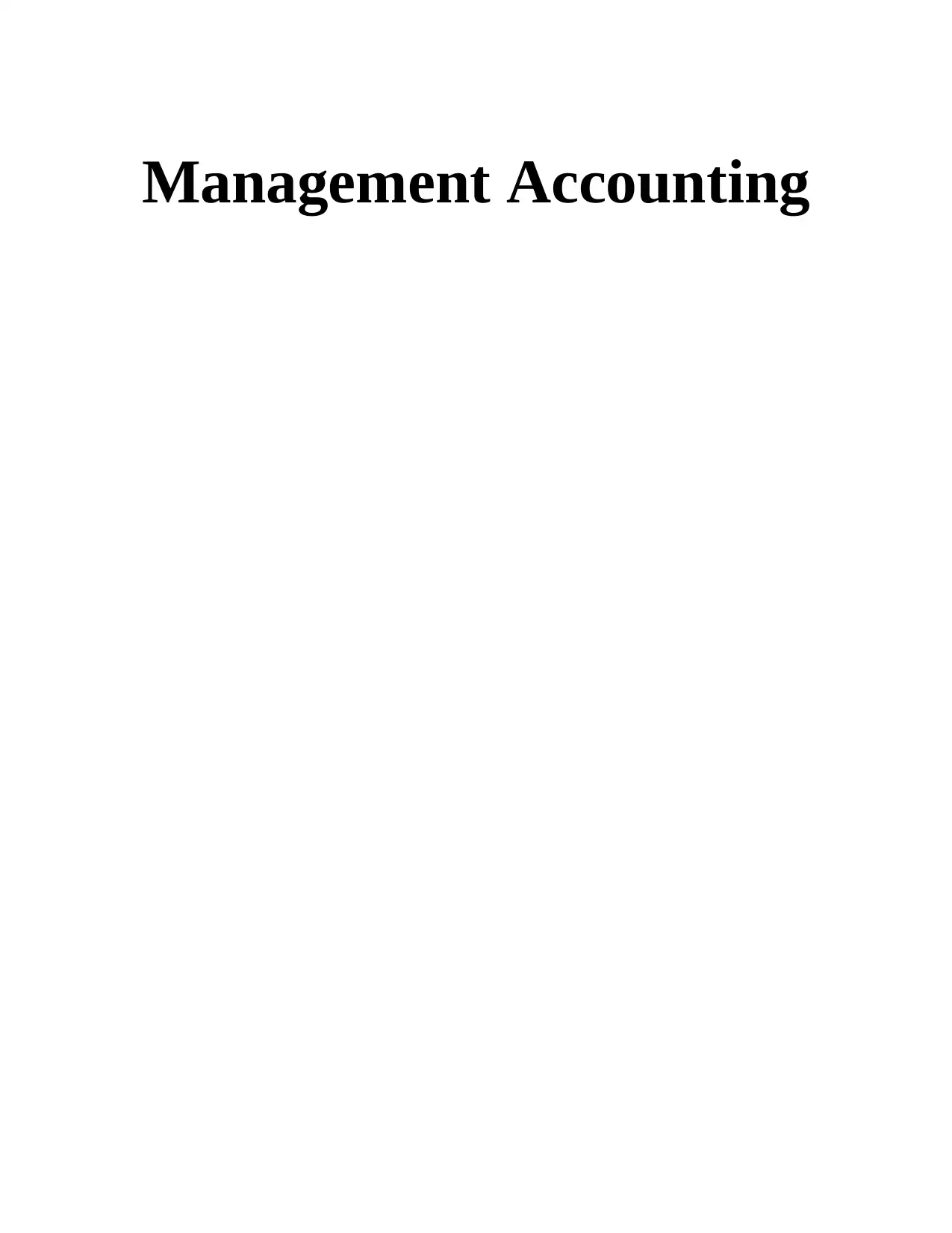
Management Accounting
Paraphrase This Document
Need a fresh take? Get an instant paraphrase of this document with our AI Paraphraser
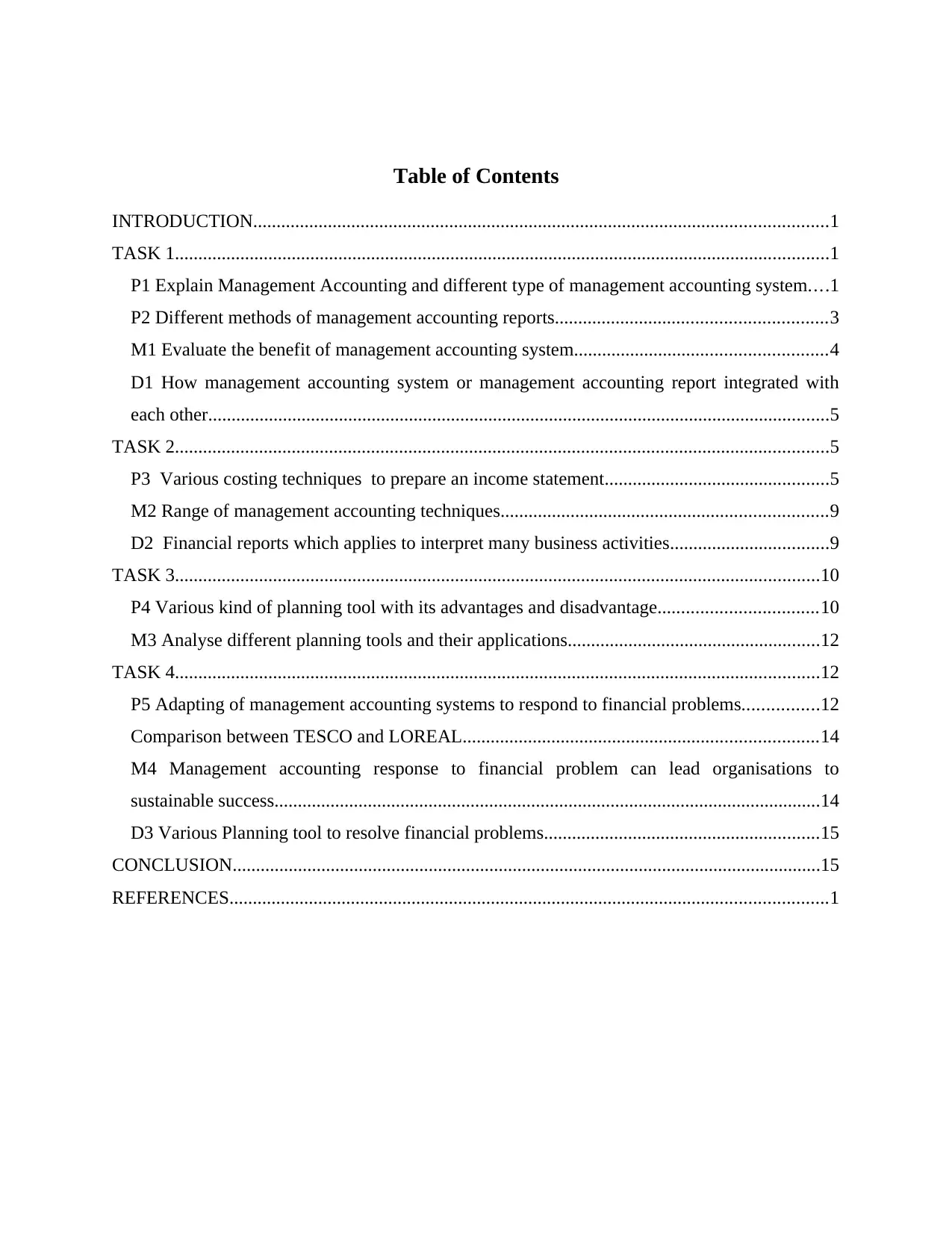
Table of Contents
INTRODUCTION...........................................................................................................................1
TASK 1............................................................................................................................................1
P1 Explain Management Accounting and different type of management accounting system....1
P2 Different methods of management accounting reports..........................................................3
M1 Evaluate the benefit of management accounting system......................................................4
D1 How management accounting system or management accounting report integrated with
each other.....................................................................................................................................5
TASK 2............................................................................................................................................5
P3 Various costing techniques to prepare an income statement................................................5
M2 Range of management accounting techniques......................................................................9
D2 Financial reports which applies to interpret many business activities..................................9
TASK 3..........................................................................................................................................10
P4 Various kind of planning tool with its advantages and disadvantage..................................10
M3 Analyse different planning tools and their applications......................................................12
TASK 4..........................................................................................................................................12
P5 Adapting of management accounting systems to respond to financial problems................12
Comparison between TESCO and LOREAL............................................................................14
M4 Management accounting response to financial problem can lead organisations to
sustainable success.....................................................................................................................14
D3 Various Planning tool to resolve financial problems...........................................................15
CONCLUSION..............................................................................................................................15
REFERENCES................................................................................................................................1
INTRODUCTION...........................................................................................................................1
TASK 1............................................................................................................................................1
P1 Explain Management Accounting and different type of management accounting system....1
P2 Different methods of management accounting reports..........................................................3
M1 Evaluate the benefit of management accounting system......................................................4
D1 How management accounting system or management accounting report integrated with
each other.....................................................................................................................................5
TASK 2............................................................................................................................................5
P3 Various costing techniques to prepare an income statement................................................5
M2 Range of management accounting techniques......................................................................9
D2 Financial reports which applies to interpret many business activities..................................9
TASK 3..........................................................................................................................................10
P4 Various kind of planning tool with its advantages and disadvantage..................................10
M3 Analyse different planning tools and their applications......................................................12
TASK 4..........................................................................................................................................12
P5 Adapting of management accounting systems to respond to financial problems................12
Comparison between TESCO and LOREAL............................................................................14
M4 Management accounting response to financial problem can lead organisations to
sustainable success.....................................................................................................................14
D3 Various Planning tool to resolve financial problems...........................................................15
CONCLUSION..............................................................................................................................15
REFERENCES................................................................................................................................1
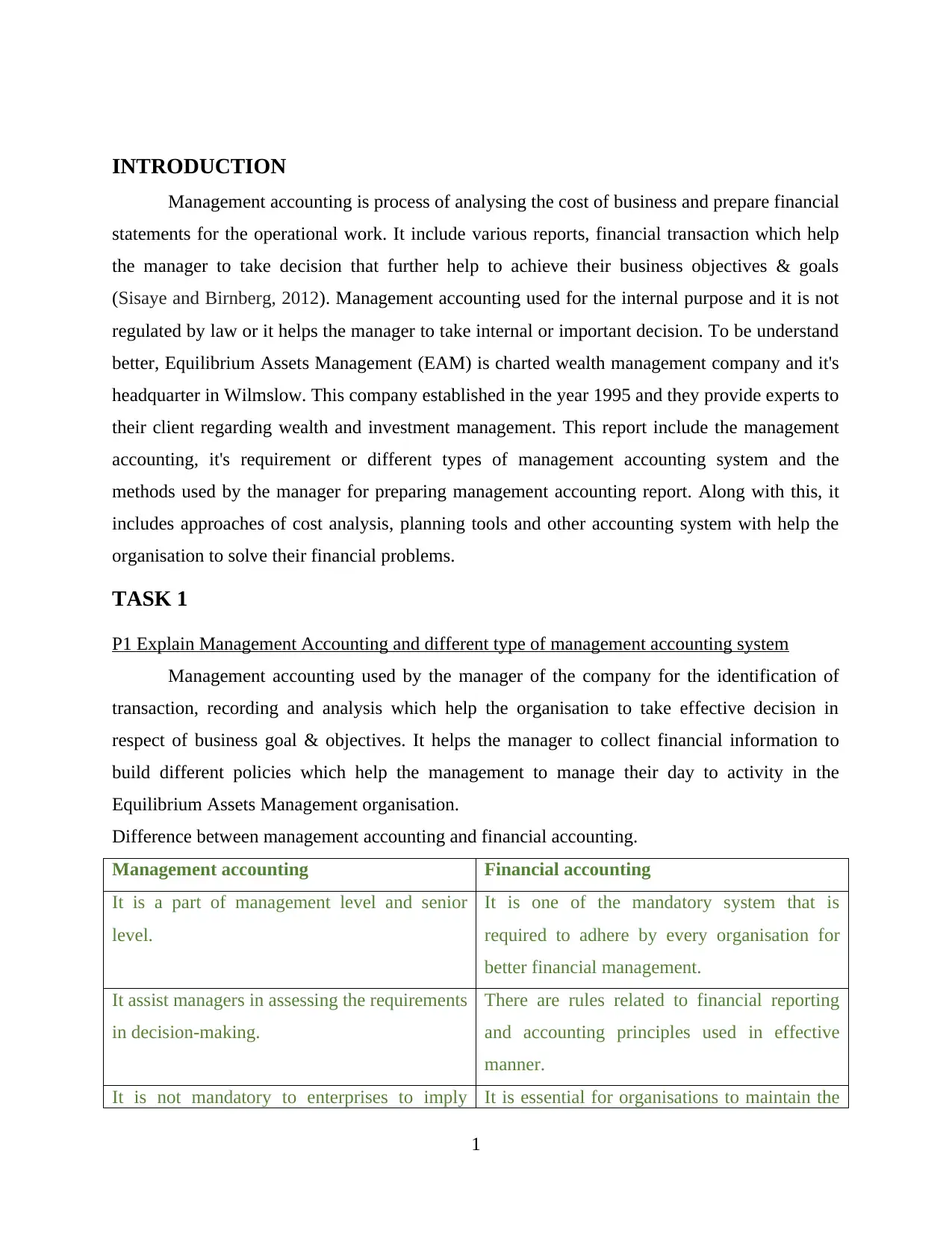
INTRODUCTION
Management accounting is process of analysing the cost of business and prepare financial
statements for the operational work. It include various reports, financial transaction which help
the manager to take decision that further help to achieve their business objectives & goals
(Sisaye and Birnberg, 2012). Management accounting used for the internal purpose and it is not
regulated by law or it helps the manager to take internal or important decision. To be understand
better, Equilibrium Assets Management (EAM) is charted wealth management company and it's
headquarter in Wilmslow. This company established in the year 1995 and they provide experts to
their client regarding wealth and investment management. This report include the management
accounting, it's requirement or different types of management accounting system and the
methods used by the manager for preparing management accounting report. Along with this, it
includes approaches of cost analysis, planning tools and other accounting system with help the
organisation to solve their financial problems.
TASK 1
P1 Explain Management Accounting and different type of management accounting system
Management accounting used by the manager of the company for the identification of
transaction, recording and analysis which help the organisation to take effective decision in
respect of business goal & objectives. It helps the manager to collect financial information to
build different policies which help the management to manage their day to activity in the
Equilibrium Assets Management organisation.
Difference between management accounting and financial accounting.
Management accounting Financial accounting
It is a part of management level and senior
level.
It is one of the mandatory system that is
required to adhere by every organisation for
better financial management.
It assist managers in assessing the requirements
in decision-making.
There are rules related to financial reporting
and accounting principles used in effective
manner.
It is not mandatory to enterprises to imply It is essential for organisations to maintain the
1
Management accounting is process of analysing the cost of business and prepare financial
statements for the operational work. It include various reports, financial transaction which help
the manager to take decision that further help to achieve their business objectives & goals
(Sisaye and Birnberg, 2012). Management accounting used for the internal purpose and it is not
regulated by law or it helps the manager to take internal or important decision. To be understand
better, Equilibrium Assets Management (EAM) is charted wealth management company and it's
headquarter in Wilmslow. This company established in the year 1995 and they provide experts to
their client regarding wealth and investment management. This report include the management
accounting, it's requirement or different types of management accounting system and the
methods used by the manager for preparing management accounting report. Along with this, it
includes approaches of cost analysis, planning tools and other accounting system with help the
organisation to solve their financial problems.
TASK 1
P1 Explain Management Accounting and different type of management accounting system
Management accounting used by the manager of the company for the identification of
transaction, recording and analysis which help the organisation to take effective decision in
respect of business goal & objectives. It helps the manager to collect financial information to
build different policies which help the management to manage their day to activity in the
Equilibrium Assets Management organisation.
Difference between management accounting and financial accounting.
Management accounting Financial accounting
It is a part of management level and senior
level.
It is one of the mandatory system that is
required to adhere by every organisation for
better financial management.
It assist managers in assessing the requirements
in decision-making.
There are rules related to financial reporting
and accounting principles used in effective
manner.
It is not mandatory to enterprises to imply It is essential for organisations to maintain the
1
⊘ This is a preview!⊘
Do you want full access?
Subscribe today to unlock all pages.

Trusted by 1+ million students worldwide
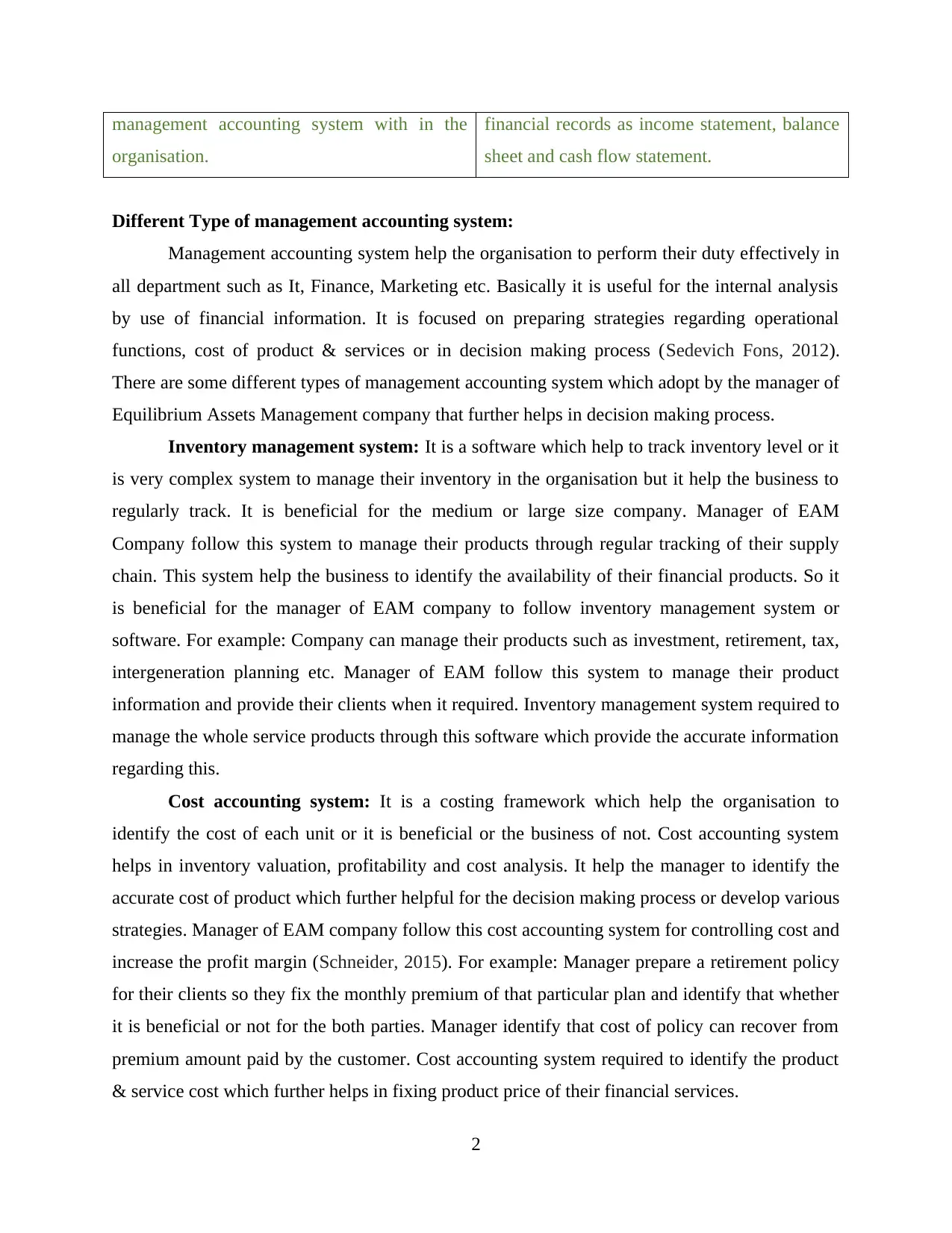
management accounting system with in the
organisation.
financial records as income statement, balance
sheet and cash flow statement.
Different Type of management accounting system:
Management accounting system help the organisation to perform their duty effectively in
all department such as It, Finance, Marketing etc. Basically it is useful for the internal analysis
by use of financial information. It is focused on preparing strategies regarding operational
functions, cost of product & services or in decision making process (Sedevich Fons, 2012).
There are some different types of management accounting system which adopt by the manager of
Equilibrium Assets Management company that further helps in decision making process.
Inventory management system: It is a software which help to track inventory level or it
is very complex system to manage their inventory in the organisation but it help the business to
regularly track. It is beneficial for the medium or large size company. Manager of EAM
Company follow this system to manage their products through regular tracking of their supply
chain. This system help the business to identify the availability of their financial products. So it
is beneficial for the manager of EAM company to follow inventory management system or
software. For example: Company can manage their products such as investment, retirement, tax,
intergeneration planning etc. Manager of EAM follow this system to manage their product
information and provide their clients when it required. Inventory management system required to
manage the whole service products through this software which provide the accurate information
regarding this.
Cost accounting system: It is a costing framework which help the organisation to
identify the cost of each unit or it is beneficial or the business of not. Cost accounting system
helps in inventory valuation, profitability and cost analysis. It help the manager to identify the
accurate cost of product which further helpful for the decision making process or develop various
strategies. Manager of EAM company follow this cost accounting system for controlling cost and
increase the profit margin (Schneider, 2015). For example: Manager prepare a retirement policy
for their clients so they fix the monthly premium of that particular plan and identify that whether
it is beneficial or not for the both parties. Manager identify that cost of policy can recover from
premium amount paid by the customer. Cost accounting system required to identify the product
& service cost which further helps in fixing product price of their financial services.
2
organisation.
financial records as income statement, balance
sheet and cash flow statement.
Different Type of management accounting system:
Management accounting system help the organisation to perform their duty effectively in
all department such as It, Finance, Marketing etc. Basically it is useful for the internal analysis
by use of financial information. It is focused on preparing strategies regarding operational
functions, cost of product & services or in decision making process (Sedevich Fons, 2012).
There are some different types of management accounting system which adopt by the manager of
Equilibrium Assets Management company that further helps in decision making process.
Inventory management system: It is a software which help to track inventory level or it
is very complex system to manage their inventory in the organisation but it help the business to
regularly track. It is beneficial for the medium or large size company. Manager of EAM
Company follow this system to manage their products through regular tracking of their supply
chain. This system help the business to identify the availability of their financial products. So it
is beneficial for the manager of EAM company to follow inventory management system or
software. For example: Company can manage their products such as investment, retirement, tax,
intergeneration planning etc. Manager of EAM follow this system to manage their product
information and provide their clients when it required. Inventory management system required to
manage the whole service products through this software which provide the accurate information
regarding this.
Cost accounting system: It is a costing framework which help the organisation to
identify the cost of each unit or it is beneficial or the business of not. Cost accounting system
helps in inventory valuation, profitability and cost analysis. It help the manager to identify the
accurate cost of product which further helpful for the decision making process or develop various
strategies. Manager of EAM company follow this cost accounting system for controlling cost and
increase the profit margin (Schneider, 2015). For example: Manager prepare a retirement policy
for their clients so they fix the monthly premium of that particular plan and identify that whether
it is beneficial or not for the both parties. Manager identify that cost of policy can recover from
premium amount paid by the customer. Cost accounting system required to identify the product
& service cost which further helps in fixing product price of their financial services.
2
Paraphrase This Document
Need a fresh take? Get an instant paraphrase of this document with our AI Paraphraser
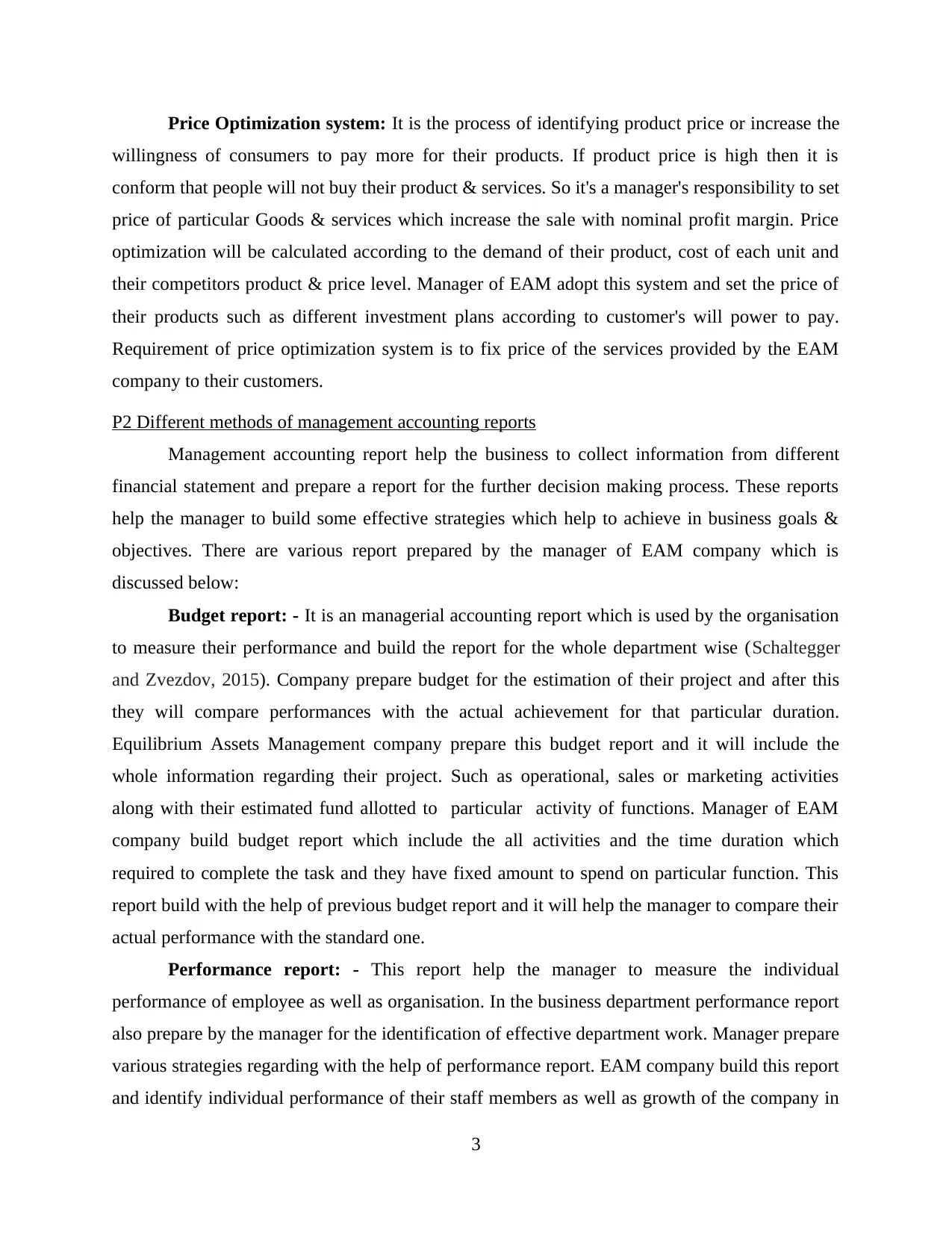
Price Optimization system: It is the process of identifying product price or increase the
willingness of consumers to pay more for their products. If product price is high then it is
conform that people will not buy their product & services. So it's a manager's responsibility to set
price of particular Goods & services which increase the sale with nominal profit margin. Price
optimization will be calculated according to the demand of their product, cost of each unit and
their competitors product & price level. Manager of EAM adopt this system and set the price of
their products such as different investment plans according to customer's will power to pay.
Requirement of price optimization system is to fix price of the services provided by the EAM
company to their customers.
P2 Different methods of management accounting reports
Management accounting report help the business to collect information from different
financial statement and prepare a report for the further decision making process. These reports
help the manager to build some effective strategies which help to achieve in business goals &
objectives. There are various report prepared by the manager of EAM company which is
discussed below:
Budget report: - It is an managerial accounting report which is used by the organisation
to measure their performance and build the report for the whole department wise (Schaltegger
and Zvezdov, 2015). Company prepare budget for the estimation of their project and after this
they will compare performances with the actual achievement for that particular duration.
Equilibrium Assets Management company prepare this budget report and it will include the
whole information regarding their project. Such as operational, sales or marketing activities
along with their estimated fund allotted to particular activity of functions. Manager of EAM
company build budget report which include the all activities and the time duration which
required to complete the task and they have fixed amount to spend on particular function. This
report build with the help of previous budget report and it will help the manager to compare their
actual performance with the standard one.
Performance report: - This report help the manager to measure the individual
performance of employee as well as organisation. In the business department performance report
also prepare by the manager for the identification of effective department work. Manager prepare
various strategies regarding with the help of performance report. EAM company build this report
and identify individual performance of their staff members as well as growth of the company in
3
willingness of consumers to pay more for their products. If product price is high then it is
conform that people will not buy their product & services. So it's a manager's responsibility to set
price of particular Goods & services which increase the sale with nominal profit margin. Price
optimization will be calculated according to the demand of their product, cost of each unit and
their competitors product & price level. Manager of EAM adopt this system and set the price of
their products such as different investment plans according to customer's will power to pay.
Requirement of price optimization system is to fix price of the services provided by the EAM
company to their customers.
P2 Different methods of management accounting reports
Management accounting report help the business to collect information from different
financial statement and prepare a report for the further decision making process. These reports
help the manager to build some effective strategies which help to achieve in business goals &
objectives. There are various report prepared by the manager of EAM company which is
discussed below:
Budget report: - It is an managerial accounting report which is used by the organisation
to measure their performance and build the report for the whole department wise (Schaltegger
and Zvezdov, 2015). Company prepare budget for the estimation of their project and after this
they will compare performances with the actual achievement for that particular duration.
Equilibrium Assets Management company prepare this budget report and it will include the
whole information regarding their project. Such as operational, sales or marketing activities
along with their estimated fund allotted to particular activity of functions. Manager of EAM
company build budget report which include the all activities and the time duration which
required to complete the task and they have fixed amount to spend on particular function. This
report build with the help of previous budget report and it will help the manager to compare their
actual performance with the standard one.
Performance report: - This report help the manager to measure the individual
performance of employee as well as organisation. In the business department performance report
also prepare by the manager for the identification of effective department work. Manager prepare
various strategies regarding with the help of performance report. EAM company build this report
and identify individual performance of their staff members as well as growth of the company in
3
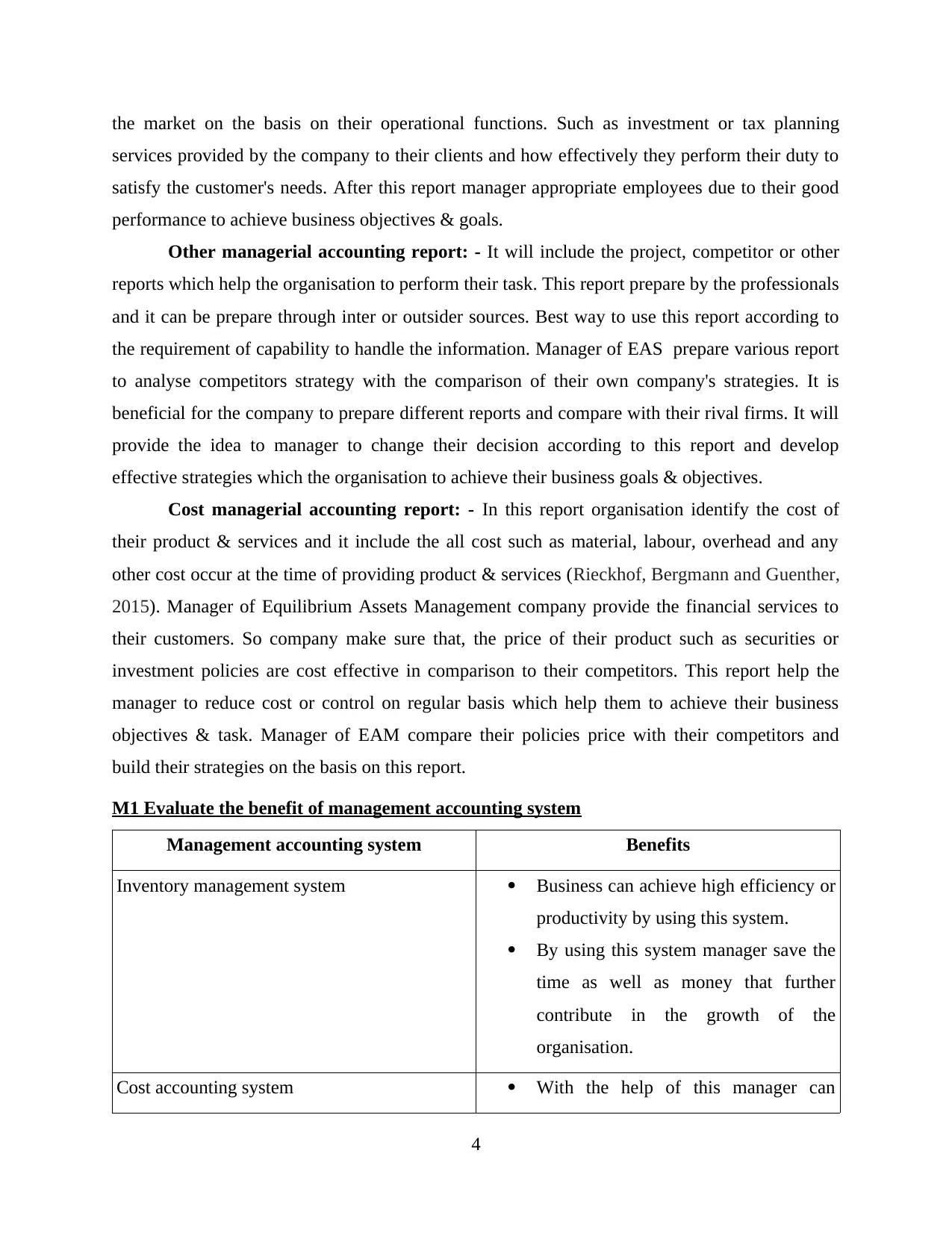
the market on the basis on their operational functions. Such as investment or tax planning
services provided by the company to their clients and how effectively they perform their duty to
satisfy the customer's needs. After this report manager appropriate employees due to their good
performance to achieve business objectives & goals.
Other managerial accounting report: - It will include the project, competitor or other
reports which help the organisation to perform their task. This report prepare by the professionals
and it can be prepare through inter or outsider sources. Best way to use this report according to
the requirement of capability to handle the information. Manager of EAS prepare various report
to analyse competitors strategy with the comparison of their own company's strategies. It is
beneficial for the company to prepare different reports and compare with their rival firms. It will
provide the idea to manager to change their decision according to this report and develop
effective strategies which the organisation to achieve their business goals & objectives.
Cost managerial accounting report: - In this report organisation identify the cost of
their product & services and it include the all cost such as material, labour, overhead and any
other cost occur at the time of providing product & services (Rieckhof, Bergmann and Guenther,
2015). Manager of Equilibrium Assets Management company provide the financial services to
their customers. So company make sure that, the price of their product such as securities or
investment policies are cost effective in comparison to their competitors. This report help the
manager to reduce cost or control on regular basis which help them to achieve their business
objectives & task. Manager of EAM compare their policies price with their competitors and
build their strategies on the basis on this report.
M1 Evaluate the benefit of management accounting system
Management accounting system Benefits
Inventory management system Business can achieve high efficiency or
productivity by using this system.
By using this system manager save the
time as well as money that further
contribute in the growth of the
organisation.
Cost accounting system With the help of this manager can
4
services provided by the company to their clients and how effectively they perform their duty to
satisfy the customer's needs. After this report manager appropriate employees due to their good
performance to achieve business objectives & goals.
Other managerial accounting report: - It will include the project, competitor or other
reports which help the organisation to perform their task. This report prepare by the professionals
and it can be prepare through inter or outsider sources. Best way to use this report according to
the requirement of capability to handle the information. Manager of EAS prepare various report
to analyse competitors strategy with the comparison of their own company's strategies. It is
beneficial for the company to prepare different reports and compare with their rival firms. It will
provide the idea to manager to change their decision according to this report and develop
effective strategies which the organisation to achieve their business goals & objectives.
Cost managerial accounting report: - In this report organisation identify the cost of
their product & services and it include the all cost such as material, labour, overhead and any
other cost occur at the time of providing product & services (Rieckhof, Bergmann and Guenther,
2015). Manager of Equilibrium Assets Management company provide the financial services to
their customers. So company make sure that, the price of their product such as securities or
investment policies are cost effective in comparison to their competitors. This report help the
manager to reduce cost or control on regular basis which help them to achieve their business
objectives & task. Manager of EAM compare their policies price with their competitors and
build their strategies on the basis on this report.
M1 Evaluate the benefit of management accounting system
Management accounting system Benefits
Inventory management system Business can achieve high efficiency or
productivity by using this system.
By using this system manager save the
time as well as money that further
contribute in the growth of the
organisation.
Cost accounting system With the help of this manager can
4
⊘ This is a preview!⊘
Do you want full access?
Subscribe today to unlock all pages.

Trusted by 1+ million students worldwide
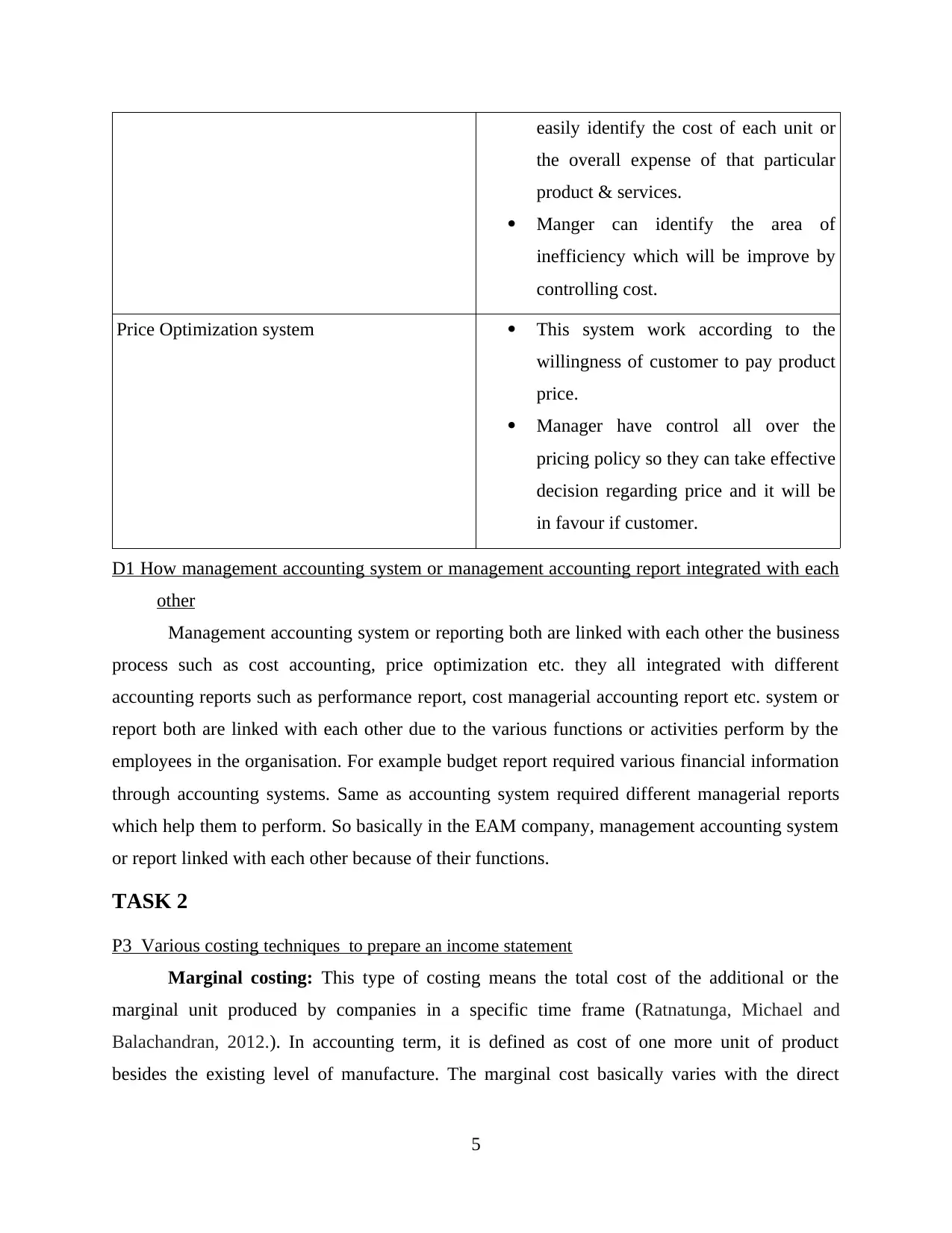
easily identify the cost of each unit or
the overall expense of that particular
product & services.
Manger can identify the area of
inefficiency which will be improve by
controlling cost.
Price Optimization system This system work according to the
willingness of customer to pay product
price.
Manager have control all over the
pricing policy so they can take effective
decision regarding price and it will be
in favour if customer.
D1 How management accounting system or management accounting report integrated with each
other
Management accounting system or reporting both are linked with each other the business
process such as cost accounting, price optimization etc. they all integrated with different
accounting reports such as performance report, cost managerial accounting report etc. system or
report both are linked with each other due to the various functions or activities perform by the
employees in the organisation. For example budget report required various financial information
through accounting systems. Same as accounting system required different managerial reports
which help them to perform. So basically in the EAM company, management accounting system
or report linked with each other because of their functions.
TASK 2
P3 Various costing techniques to prepare an income statement
Marginal costing: This type of costing means the total cost of the additional or the
marginal unit produced by companies in a specific time frame (Ratnatunga, Michael and
Balachandran, 2012.). In accounting term, it is defined as cost of one more unit of product
besides the existing level of manufacture. The marginal cost basically varies with the direct
5
the overall expense of that particular
product & services.
Manger can identify the area of
inefficiency which will be improve by
controlling cost.
Price Optimization system This system work according to the
willingness of customer to pay product
price.
Manager have control all over the
pricing policy so they can take effective
decision regarding price and it will be
in favour if customer.
D1 How management accounting system or management accounting report integrated with each
other
Management accounting system or reporting both are linked with each other the business
process such as cost accounting, price optimization etc. they all integrated with different
accounting reports such as performance report, cost managerial accounting report etc. system or
report both are linked with each other due to the various functions or activities perform by the
employees in the organisation. For example budget report required various financial information
through accounting systems. Same as accounting system required different managerial reports
which help them to perform. So basically in the EAM company, management accounting system
or report linked with each other because of their functions.
TASK 2
P3 Various costing techniques to prepare an income statement
Marginal costing: This type of costing means the total cost of the additional or the
marginal unit produced by companies in a specific time frame (Ratnatunga, Michael and
Balachandran, 2012.). In accounting term, it is defined as cost of one more unit of product
besides the existing level of manufacture. The marginal cost basically varies with the direct
5
Paraphrase This Document
Need a fresh take? Get an instant paraphrase of this document with our AI Paraphraser
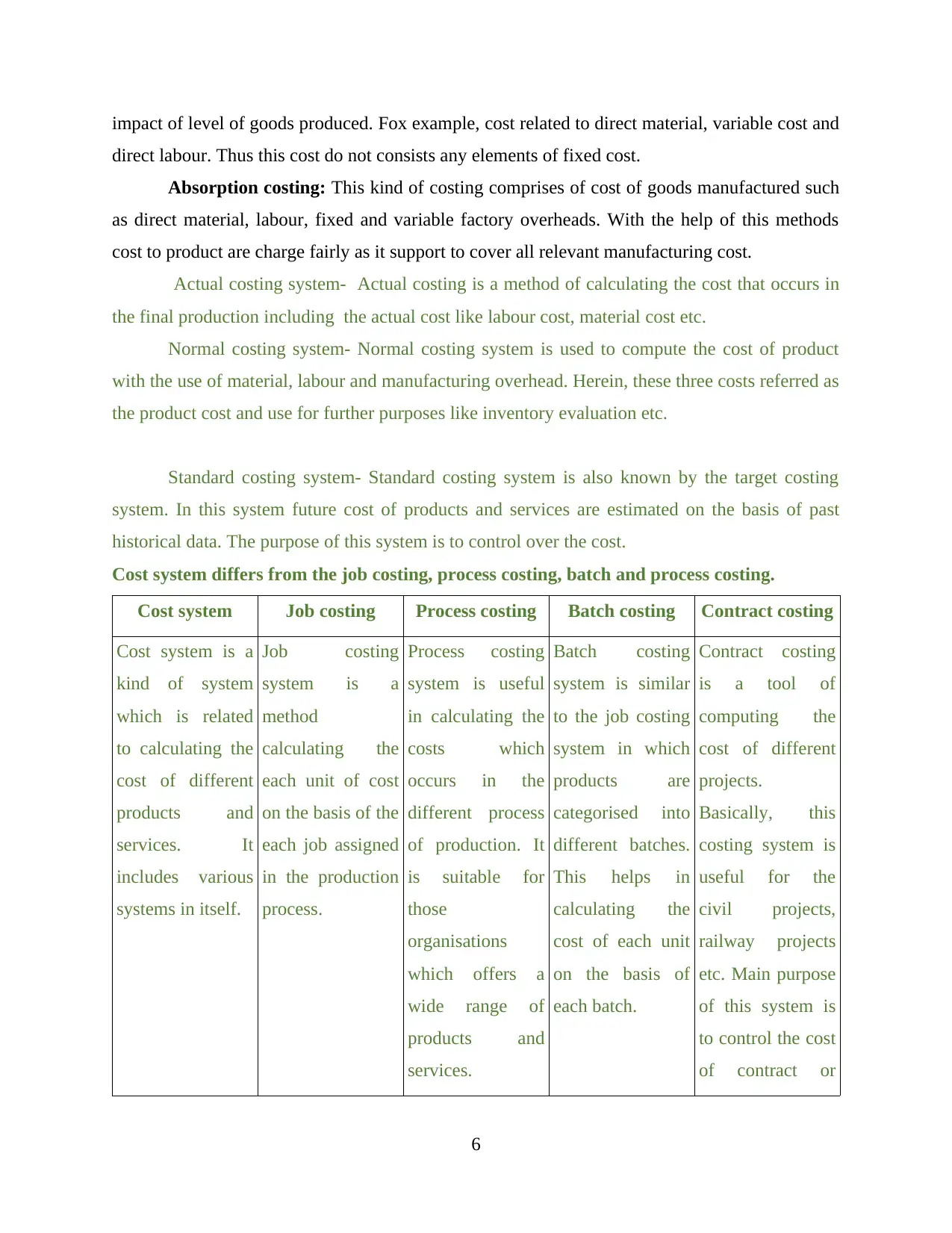
impact of level of goods produced. Fox example, cost related to direct material, variable cost and
direct labour. Thus this cost do not consists any elements of fixed cost.
Absorption costing: This kind of costing comprises of cost of goods manufactured such
as direct material, labour, fixed and variable factory overheads. With the help of this methods
cost to product are charge fairly as it support to cover all relevant manufacturing cost.
Actual costing system- Actual costing is a method of calculating the cost that occurs in
the final production including the actual cost like labour cost, material cost etc.
Normal costing system- Normal costing system is used to compute the cost of product
with the use of material, labour and manufacturing overhead. Herein, these three costs referred as
the product cost and use for further purposes like inventory evaluation etc.
Standard costing system- Standard costing system is also known by the target costing
system. In this system future cost of products and services are estimated on the basis of past
historical data. The purpose of this system is to control over the cost.
Cost system differs from the job costing, process costing, batch and process costing.
Cost system Job costing Process costing Batch costing Contract costing
Cost system is a
kind of system
which is related
to calculating the
cost of different
products and
services. It
includes various
systems in itself.
Job costing
system is a
method
calculating the
each unit of cost
on the basis of the
each job assigned
in the production
process.
Process costing
system is useful
in calculating the
costs which
occurs in the
different process
of production. It
is suitable for
those
organisations
which offers a
wide range of
products and
services.
Batch costing
system is similar
to the job costing
system in which
products are
categorised into
different batches.
This helps in
calculating the
cost of each unit
on the basis of
each batch.
Contract costing
is a tool of
computing the
cost of different
projects.
Basically, this
costing system is
useful for the
civil projects,
railway projects
etc. Main purpose
of this system is
to control the cost
of contract or
6
direct labour. Thus this cost do not consists any elements of fixed cost.
Absorption costing: This kind of costing comprises of cost of goods manufactured such
as direct material, labour, fixed and variable factory overheads. With the help of this methods
cost to product are charge fairly as it support to cover all relevant manufacturing cost.
Actual costing system- Actual costing is a method of calculating the cost that occurs in
the final production including the actual cost like labour cost, material cost etc.
Normal costing system- Normal costing system is used to compute the cost of product
with the use of material, labour and manufacturing overhead. Herein, these three costs referred as
the product cost and use for further purposes like inventory evaluation etc.
Standard costing system- Standard costing system is also known by the target costing
system. In this system future cost of products and services are estimated on the basis of past
historical data. The purpose of this system is to control over the cost.
Cost system differs from the job costing, process costing, batch and process costing.
Cost system Job costing Process costing Batch costing Contract costing
Cost system is a
kind of system
which is related
to calculating the
cost of different
products and
services. It
includes various
systems in itself.
Job costing
system is a
method
calculating the
each unit of cost
on the basis of the
each job assigned
in the production
process.
Process costing
system is useful
in calculating the
costs which
occurs in the
different process
of production. It
is suitable for
those
organisations
which offers a
wide range of
products and
services.
Batch costing
system is similar
to the job costing
system in which
products are
categorised into
different batches.
This helps in
calculating the
cost of each unit
on the basis of
each batch.
Contract costing
is a tool of
computing the
cost of different
projects.
Basically, this
costing system is
useful for the
civil projects,
railway projects
etc. Main purpose
of this system is
to control the cost
of contract or
6
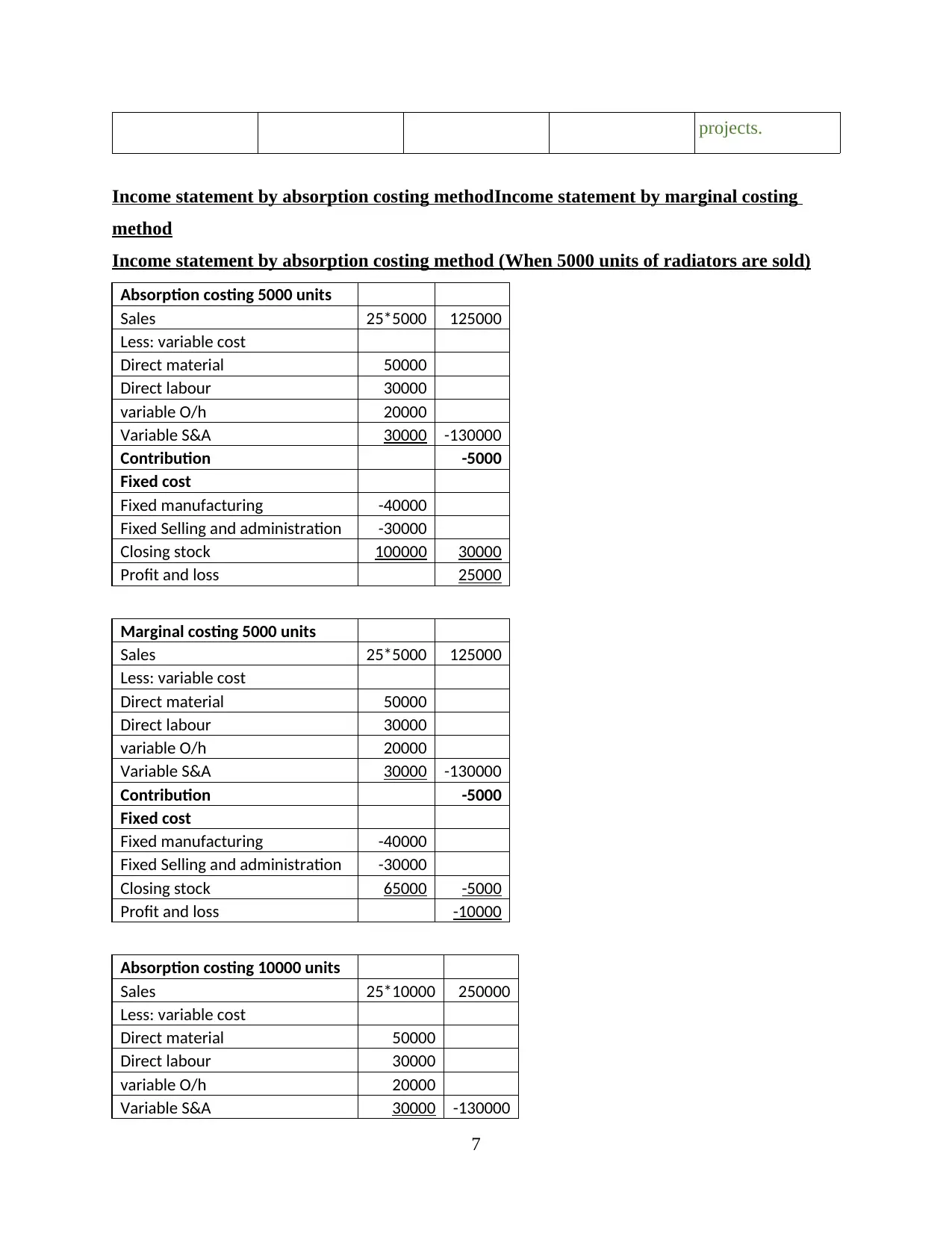
projects.
Income statement by absorption costing methodIncome statement by marginal costing
method
Income statement by absorption costing method (When 5000 units of radiators are sold)
Absorption costing 5000 units
Sales 25*5000 125000
Less: variable cost
Direct material 50000
Direct labour 30000
variable O/h 20000
Variable S&A 30000 -130000
Contribution -5000
Fixed cost
Fixed manufacturing -40000
Fixed Selling and administration -30000
Closing stock 100000 30000
Profit and loss 25000
Marginal costing 5000 units
Sales 25*5000 125000
Less: variable cost
Direct material 50000
Direct labour 30000
variable O/h 20000
Variable S&A 30000 -130000
Contribution -5000
Fixed cost
Fixed manufacturing -40000
Fixed Selling and administration -30000
Closing stock 65000 -5000
Profit and loss -10000
Absorption costing 10000 units
Sales 25*10000 250000
Less: variable cost
Direct material 50000
Direct labour 30000
variable O/h 20000
Variable S&A 30000 -130000
7
Income statement by absorption costing methodIncome statement by marginal costing
method
Income statement by absorption costing method (When 5000 units of radiators are sold)
Absorption costing 5000 units
Sales 25*5000 125000
Less: variable cost
Direct material 50000
Direct labour 30000
variable O/h 20000
Variable S&A 30000 -130000
Contribution -5000
Fixed cost
Fixed manufacturing -40000
Fixed Selling and administration -30000
Closing stock 100000 30000
Profit and loss 25000
Marginal costing 5000 units
Sales 25*5000 125000
Less: variable cost
Direct material 50000
Direct labour 30000
variable O/h 20000
Variable S&A 30000 -130000
Contribution -5000
Fixed cost
Fixed manufacturing -40000
Fixed Selling and administration -30000
Closing stock 65000 -5000
Profit and loss -10000
Absorption costing 10000 units
Sales 25*10000 250000
Less: variable cost
Direct material 50000
Direct labour 30000
variable O/h 20000
Variable S&A 30000 -130000
7
⊘ This is a preview!⊘
Do you want full access?
Subscribe today to unlock all pages.

Trusted by 1+ million students worldwide
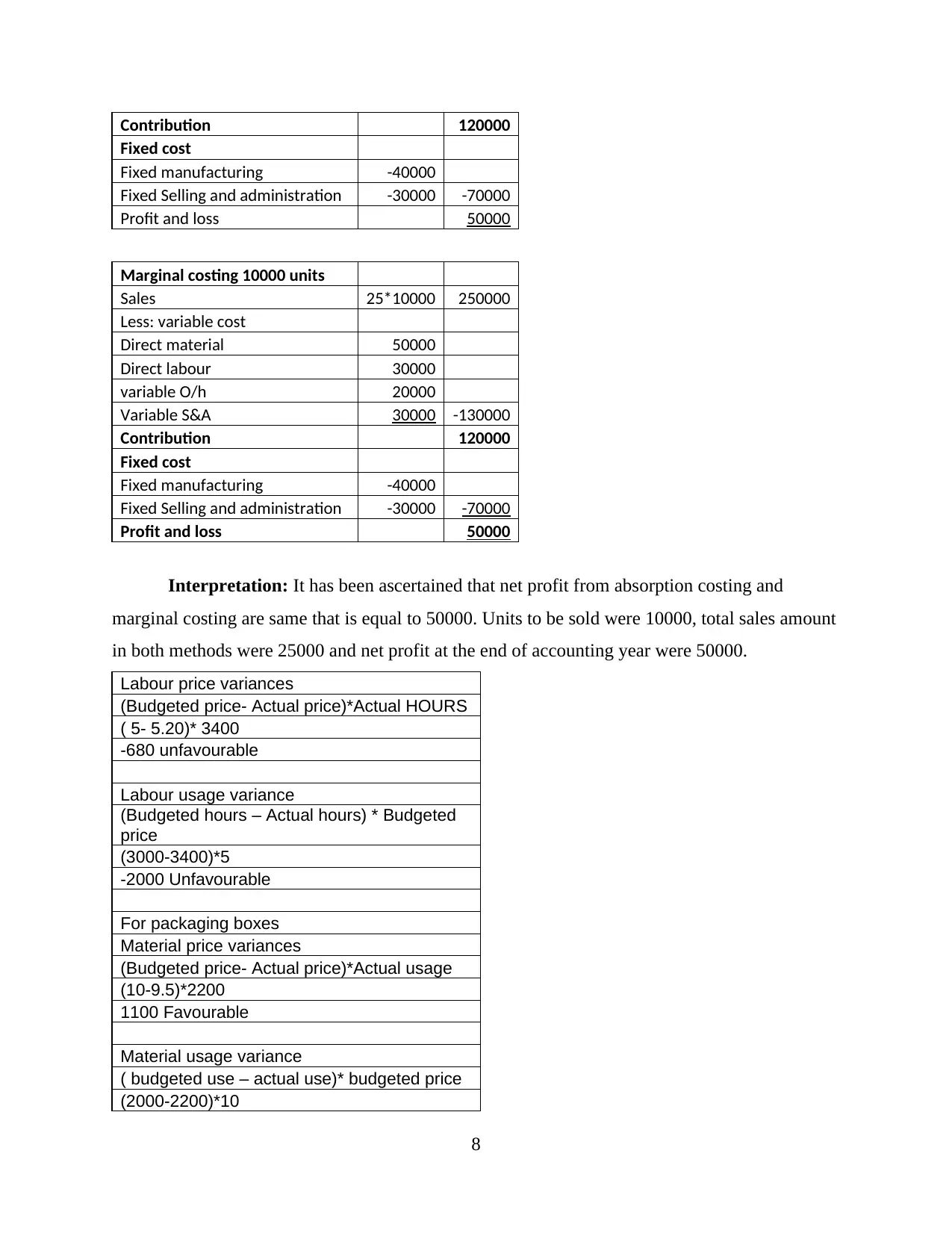
Contribution 120000
Fixed cost
Fixed manufacturing -40000
Fixed Selling and administration -30000 -70000
Profit and loss 50000
Marginal costing 10000 units
Sales 25*10000 250000
Less: variable cost
Direct material 50000
Direct labour 30000
variable O/h 20000
Variable S&A 30000 -130000
Contribution 120000
Fixed cost
Fixed manufacturing -40000
Fixed Selling and administration -30000 -70000
Profit and loss 50000
Interpretation: It has been ascertained that net profit from absorption costing and
marginal costing are same that is equal to 50000. Units to be sold were 10000, total sales amount
in both methods were 25000 and net profit at the end of accounting year were 50000.
Labour price variances
(Budgeted price- Actual price)*Actual HOURS
( 5- 5.20)* 3400
-680 unfavourable
Labour usage variance
(Budgeted hours – Actual hours) * Budgeted
price
(3000-3400)*5
-2000 Unfavourable
For packaging boxes
Material price variances
(Budgeted price- Actual price)*Actual usage
(10-9.5)*2200
1100 Favourable
Material usage variance
( budgeted use – actual use)* budgeted price
(2000-2200)*10
8
Fixed cost
Fixed manufacturing -40000
Fixed Selling and administration -30000 -70000
Profit and loss 50000
Marginal costing 10000 units
Sales 25*10000 250000
Less: variable cost
Direct material 50000
Direct labour 30000
variable O/h 20000
Variable S&A 30000 -130000
Contribution 120000
Fixed cost
Fixed manufacturing -40000
Fixed Selling and administration -30000 -70000
Profit and loss 50000
Interpretation: It has been ascertained that net profit from absorption costing and
marginal costing are same that is equal to 50000. Units to be sold were 10000, total sales amount
in both methods were 25000 and net profit at the end of accounting year were 50000.
Labour price variances
(Budgeted price- Actual price)*Actual HOURS
( 5- 5.20)* 3400
-680 unfavourable
Labour usage variance
(Budgeted hours – Actual hours) * Budgeted
price
(3000-3400)*5
-2000 Unfavourable
For packaging boxes
Material price variances
(Budgeted price- Actual price)*Actual usage
(10-9.5)*2200
1100 Favourable
Material usage variance
( budgeted use – actual use)* budgeted price
(2000-2200)*10
8
Paraphrase This Document
Need a fresh take? Get an instant paraphrase of this document with our AI Paraphraser
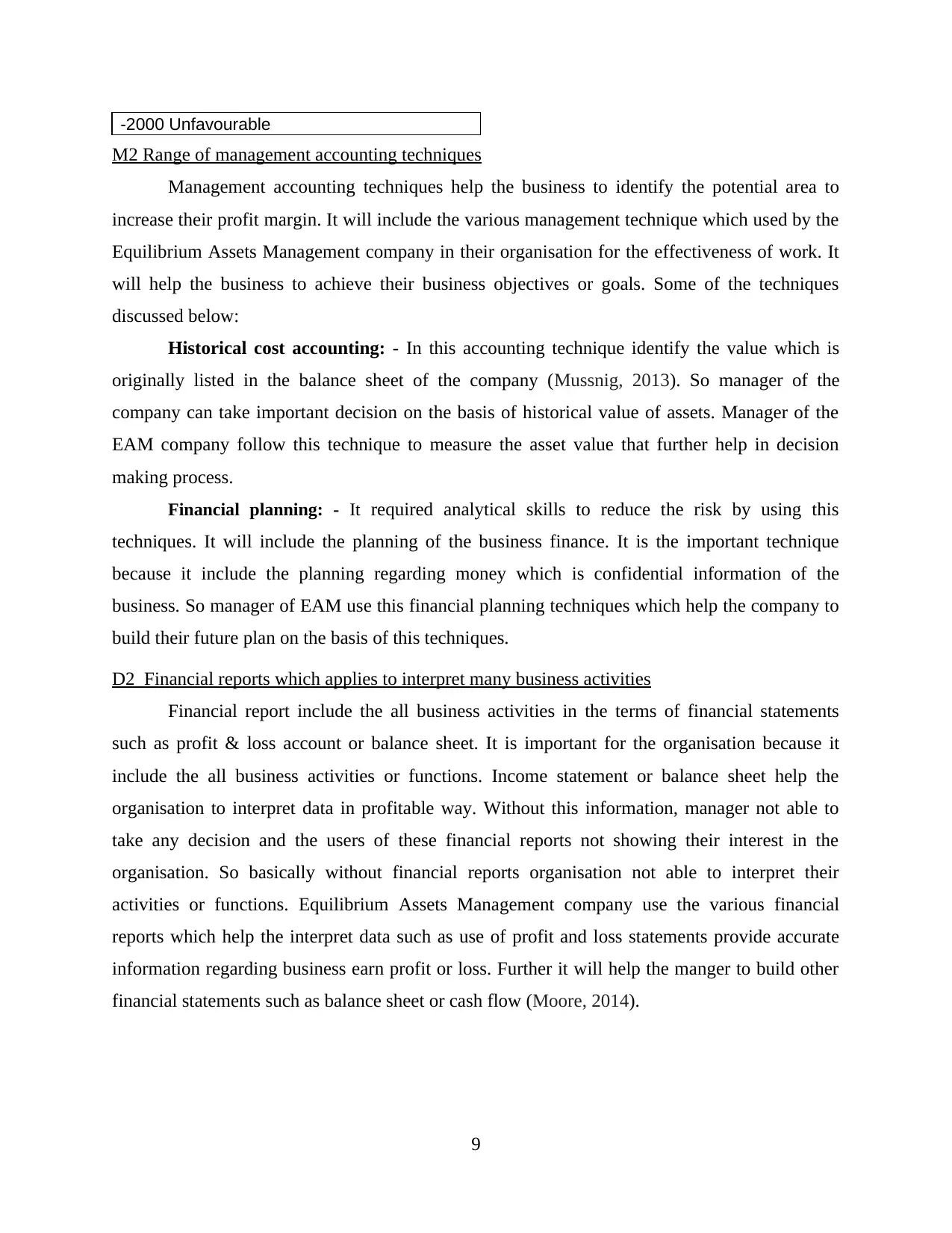
-2000 Unfavourable
M2 Range of management accounting techniques
Management accounting techniques help the business to identify the potential area to
increase their profit margin. It will include the various management technique which used by the
Equilibrium Assets Management company in their organisation for the effectiveness of work. It
will help the business to achieve their business objectives or goals. Some of the techniques
discussed below:
Historical cost accounting: - In this accounting technique identify the value which is
originally listed in the balance sheet of the company (Mussnig, 2013). So manager of the
company can take important decision on the basis of historical value of assets. Manager of the
EAM company follow this technique to measure the asset value that further help in decision
making process.
Financial planning: - It required analytical skills to reduce the risk by using this
techniques. It will include the planning of the business finance. It is the important technique
because it include the planning regarding money which is confidential information of the
business. So manager of EAM use this financial planning techniques which help the company to
build their future plan on the basis of this techniques.
D2 Financial reports which applies to interpret many business activities
Financial report include the all business activities in the terms of financial statements
such as profit & loss account or balance sheet. It is important for the organisation because it
include the all business activities or functions. Income statement or balance sheet help the
organisation to interpret data in profitable way. Without this information, manager not able to
take any decision and the users of these financial reports not showing their interest in the
organisation. So basically without financial reports organisation not able to interpret their
activities or functions. Equilibrium Assets Management company use the various financial
reports which help the interpret data such as use of profit and loss statements provide accurate
information regarding business earn profit or loss. Further it will help the manger to build other
financial statements such as balance sheet or cash flow (Moore, 2014).
9
M2 Range of management accounting techniques
Management accounting techniques help the business to identify the potential area to
increase their profit margin. It will include the various management technique which used by the
Equilibrium Assets Management company in their organisation for the effectiveness of work. It
will help the business to achieve their business objectives or goals. Some of the techniques
discussed below:
Historical cost accounting: - In this accounting technique identify the value which is
originally listed in the balance sheet of the company (Mussnig, 2013). So manager of the
company can take important decision on the basis of historical value of assets. Manager of the
EAM company follow this technique to measure the asset value that further help in decision
making process.
Financial planning: - It required analytical skills to reduce the risk by using this
techniques. It will include the planning of the business finance. It is the important technique
because it include the planning regarding money which is confidential information of the
business. So manager of EAM use this financial planning techniques which help the company to
build their future plan on the basis of this techniques.
D2 Financial reports which applies to interpret many business activities
Financial report include the all business activities in the terms of financial statements
such as profit & loss account or balance sheet. It is important for the organisation because it
include the all business activities or functions. Income statement or balance sheet help the
organisation to interpret data in profitable way. Without this information, manager not able to
take any decision and the users of these financial reports not showing their interest in the
organisation. So basically without financial reports organisation not able to interpret their
activities or functions. Equilibrium Assets Management company use the various financial
reports which help the interpret data such as use of profit and loss statements provide accurate
information regarding business earn profit or loss. Further it will help the manger to build other
financial statements such as balance sheet or cash flow (Moore, 2014).
9
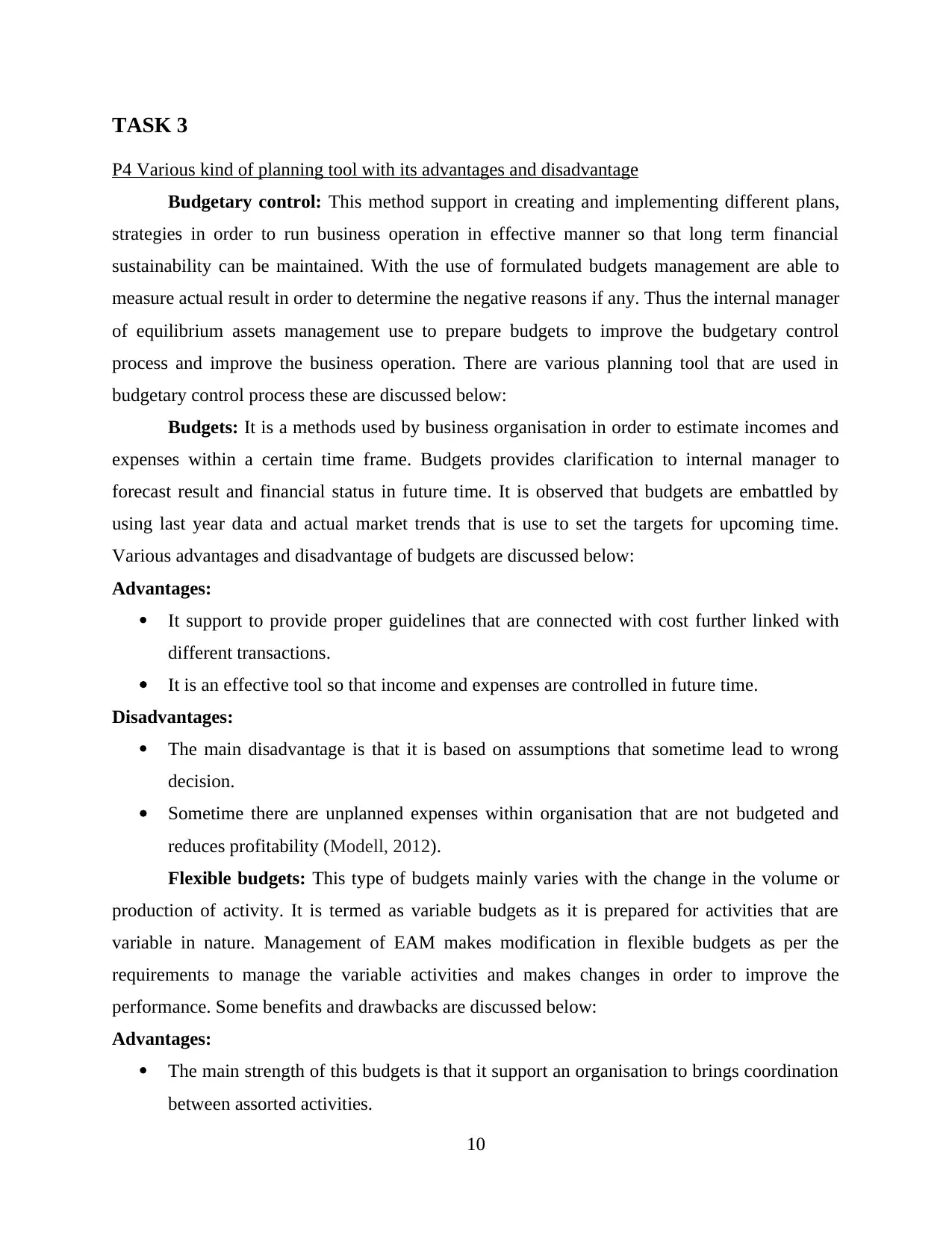
TASK 3
P4 Various kind of planning tool with its advantages and disadvantage
Budgetary control: This method support in creating and implementing different plans,
strategies in order to run business operation in effective manner so that long term financial
sustainability can be maintained. With the use of formulated budgets management are able to
measure actual result in order to determine the negative reasons if any. Thus the internal manager
of equilibrium assets management use to prepare budgets to improve the budgetary control
process and improve the business operation. There are various planning tool that are used in
budgetary control process these are discussed below:
Budgets: It is a methods used by business organisation in order to estimate incomes and
expenses within a certain time frame. Budgets provides clarification to internal manager to
forecast result and financial status in future time. It is observed that budgets are embattled by
using last year data and actual market trends that is use to set the targets for upcoming time.
Various advantages and disadvantage of budgets are discussed below:
Advantages:
It support to provide proper guidelines that are connected with cost further linked with
different transactions.
It is an effective tool so that income and expenses are controlled in future time.
Disadvantages:
The main disadvantage is that it is based on assumptions that sometime lead to wrong
decision.
Sometime there are unplanned expenses within organisation that are not budgeted and
reduces profitability (Modell, 2012).
Flexible budgets: This type of budgets mainly varies with the change in the volume or
production of activity. It is termed as variable budgets as it is prepared for activities that are
variable in nature. Management of EAM makes modification in flexible budgets as per the
requirements to manage the variable activities and makes changes in order to improve the
performance. Some benefits and drawbacks are discussed below:
Advantages:
The main strength of this budgets is that it support an organisation to brings coordination
between assorted activities.
10
P4 Various kind of planning tool with its advantages and disadvantage
Budgetary control: This method support in creating and implementing different plans,
strategies in order to run business operation in effective manner so that long term financial
sustainability can be maintained. With the use of formulated budgets management are able to
measure actual result in order to determine the negative reasons if any. Thus the internal manager
of equilibrium assets management use to prepare budgets to improve the budgetary control
process and improve the business operation. There are various planning tool that are used in
budgetary control process these are discussed below:
Budgets: It is a methods used by business organisation in order to estimate incomes and
expenses within a certain time frame. Budgets provides clarification to internal manager to
forecast result and financial status in future time. It is observed that budgets are embattled by
using last year data and actual market trends that is use to set the targets for upcoming time.
Various advantages and disadvantage of budgets are discussed below:
Advantages:
It support to provide proper guidelines that are connected with cost further linked with
different transactions.
It is an effective tool so that income and expenses are controlled in future time.
Disadvantages:
The main disadvantage is that it is based on assumptions that sometime lead to wrong
decision.
Sometime there are unplanned expenses within organisation that are not budgeted and
reduces profitability (Modell, 2012).
Flexible budgets: This type of budgets mainly varies with the change in the volume or
production of activity. It is termed as variable budgets as it is prepared for activities that are
variable in nature. Management of EAM makes modification in flexible budgets as per the
requirements to manage the variable activities and makes changes in order to improve the
performance. Some benefits and drawbacks are discussed below:
Advantages:
The main strength of this budgets is that it support an organisation to brings coordination
between assorted activities.
10
⊘ This is a preview!⊘
Do you want full access?
Subscribe today to unlock all pages.

Trusted by 1+ million students worldwide
1 out of 18
Related Documents
Your All-in-One AI-Powered Toolkit for Academic Success.
+13062052269
info@desklib.com
Available 24*7 on WhatsApp / Email
![[object Object]](/_next/static/media/star-bottom.7253800d.svg)
Unlock your academic potential
Copyright © 2020–2025 A2Z Services. All Rights Reserved. Developed and managed by ZUCOL.





